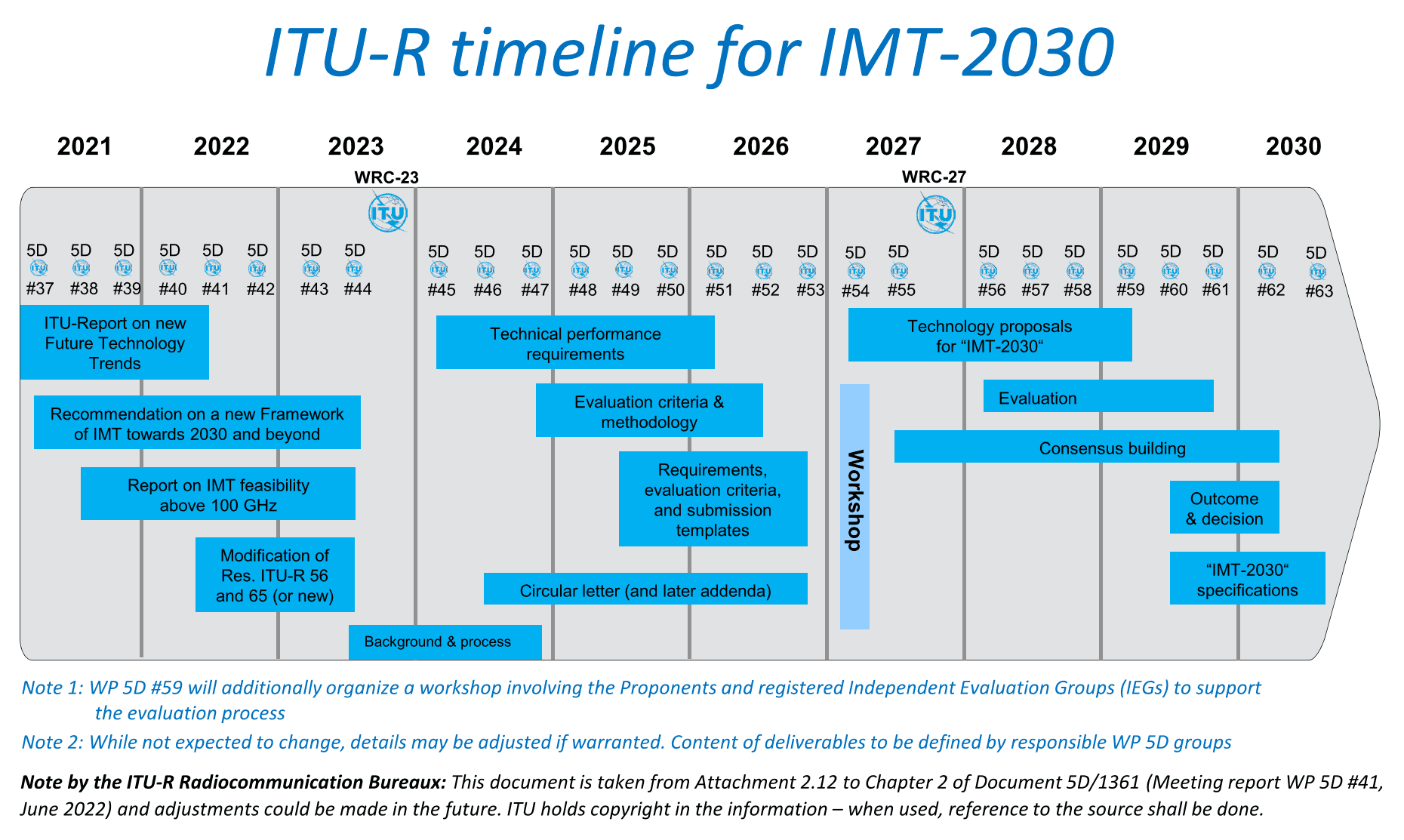ITU-R WP5D invites IMT-2030 RIT/SRIT contributions
ITU-R has commenced the process of developing ITU-R Recommendations for the terrestrial components of the IMT-2030 (6G) radio interface(s). This work is guided by Resolutions ITU-R 56 and ITU-R 65. As you can see from the timeline below, the final IMT-2030 recommendation won’t be completed until 2030.
The ITU Radiocommunication Bureau has established a “Web page for the IMT-2030 submission and evaluation process” to facilitate the development of proposals and the work of the evaluation groups. The IMT-2030 web page will provide details of the process for the submission of proposals, and will include the RIT and SRIT submissions, evaluation group registration and contact information, evaluation reports and other relevant information on the development of IMT‑2030.
Candidate RITs (Radio Interface Technologies) or SRITs (Set of Radio Interface Technologies) will be evaluated by the ITU membership, standards organizations and other independent evaluation groups. Evaluation groups are requested to register with ITU-R1, preferably before [February/the end of 2027].
The evaluation groups are kindly requested to submit evaluation reports to the ITU-R in accordance with the evaluation process delineated on the IMT‑2030 web page. The evaluation reports will be considered in the development of the ITU-R Recommendation describing the radio interface specifications.
The evaluation guidelines, including the criteria and methodology, are to be finalized by WP 5D in June 2026. The availability of these guidelines on the IMT-2030 web page will be announced in a forthcoming Addendum to a Circular Letter calling for IMT-2030 RIT/SRIT contributions.
3GPP’s contributions will most likely be presented to ITU-R WP5D by ATIS. It remains to be seen what other entities will submit IMT-2030 RIT/SRIT proposals.
References:
https://www.itu.int/en/ITU-R/study-groups/rsg5/rwp5d/imt-2030/Pages/default.aspx
https://www.itu.int/dms_pub/itu-r/oth/0a/06/R0A060000C80001PDFE.pdf
Highlights of 3GPP Stage 1 Workshop on IMT 2030 (6G) Use Cases
NGMN issues ITU-R framework for IMT-2030 vs ITU-R WP5D Timeline for RIT/SRIT Standardization
IMT-2030 Technical Performance Requirements (TPR) from ITU-R WP5D
Draft new ITU-R recommendation (not yet approved): M.[IMT.FRAMEWORK FOR 2030 AND BEYOND]
One thought on “ITU-R WP5D invites IMT-2030 RIT/SRIT contributions”
Comments are closed.



6G goals and drivers:
Here are the key goals and drivers for the 6G innovation platform to achieve in the next decade and beyond:
-Economics growth: 6G is poised to unlock novel revenue streams, and enable a plethora of new devices, services and deployments. Although it may be premature — or even naïve — to quantify its impact at this point of time, 6G is anticipated to be a significant driver of sustained global economic growth, fostering industry innovations and transformations.
-Technology advancement: While innovation is a continuous process, commercializing major breakthroughs in core technologies efficiently must wait for a generational transition, when a blank-slate design can be introduced. 6G can align ecosystem investments to bring the next big leap in wireless technology, enabling the convergence of advanced communication, precise sensing and localization, artificial intelligence (AI) and computing technologies.
-Cost efficiency: One early learning from deploying 5G networks is that many new technologies can be expensive to roll out broadly. Today, mobile operators are looking for ways to reduce the total cost of ownership (TCO) of their networks. Reducing network energy consumption can optimize operational cost, but to save on capital expenditure, a software-centric system with network APIs can allow mobile operators to leverage their 5G investment.
-Societal equity: 6G will continue to foster digital inclusion, enabling cost-effective technologies that can broadly deliver 6G access to bridge the digital divide. New 6G technologies can promote quality of life improvements, with democratized access to public services such as healthcare, education and public safety.
-Environmental sustainability: A common theme across the different global 6G visions is for it to promote a greener future. This anchors both in efficient 6G network operations (i.e., energy savings, eco-friendly deployment footprint) as well as more sustainable vertical industries (e.g., smart transportation, precision agriculture and more).
-Trust and reliability: The cellular evolution has consistently emphasized the importance of security and privacy, with each generation aiming to enhance trustworthiness. As we look towards 6G, it’s anticipated to uphold this legacy by integrating cutting-edge technologies such as quantum-safe communications and AI-driven security.
https://www.qualcomm.com/news/onq/2024/06/path-to-6g-envisioning-next-gen-use-cases-for-2030-and-beyond